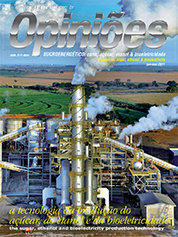Jaime Finguerut
Strategic Development Manager of CTC
Op-AA-27
State-of-the-art of technology
Processing sugarcane in the country is a mature activity, which made it possible for Brazil to become the second largest producer of ethanol and the largest exporter of sugar and ethanol. This important economic activity nowadays represents almost 2% of GDP, the same business magnitude as the production of plastic, for example.
The industry is an important employer, with a high degree of formalization, providing income and job opportunities in the country’s interior. Sugarcane’s industrial process has grown in scope (volume crushed per harvest and per day), without, however, having lost efficiency and without increasing its environmental “footprint”.
Several analyses of our way of producing, conducted both by academy and by governmental bodies of other countries, confirm the sustainability of our business, particularly in comparison with other conventional products, such as those of fossil origin. Brazilian sugar is the source of calories that occupies the smallest area, uses the least volume of water and generates more jobs than any other available kind of food.
How was it possible to reach this situation? There were historical reasons: since the beginning we have made efforts in the production of sugarcane and in exporting sucrose in different forms. Early on, we were exposed to competition from other colonies, some of which enjoyed economic and logistic advantages, and even so we were never responsible for less than 15% of the world market for sweeteners.
In all these years, we faced many crises, catastrophes, new diseases, plagues and even wars, but all this did not prevent us from continuing to produce competitively. Actually, right from the beginning, production was in private hands, with variable degrees of governmental protection.
Apart from historical reasons, our attachment to the market (domestic and foreign) made us shape the production process so that it would always be viable. For example: we have one of the highest costs of capital in the world, which forced us to increase production, mainly through productivity gains, i.e., by doing increasingly more with less.
A same crushing mill nowadays crushes more than double – per unit of equipment weight and energy spent to operate it –, the volume of sugarcane in comparison with when the “Proálcool” program started. The same happened with fermentation, the productivity gains (efficiency gains – more ethanol produced with the same volume of sugar –, and reduction in fermentation time), which exceeded 100%.
Hence, in view of an unfavorable domestic scenario, our capacity to meet market requirements made us innovate and evolve. In this aspect, the existence of national research and development bodies, national engineering capacity – equipment manufacturers –, and policies and incentives were all success factors. In general, the outcome is the mature process I already referred to.
But what is a mature process? It is one in which the cost of raw material is the highest, i.e., problems were gradually solved – for instance, expenses with chemical products and other inputs (including water), energy, maintenance, the disposition of residues, capital (investments), leaving only the raw material cost. Compare our production of ethanol from sugarcane with that of corn.
Energy (purchased - natural gas - USA) is very expensive, it uses more enzymes and yeast, enormous stainless steel equipment and requires high levels of cleaning and sterilizing, which leads us to conclude that the production from corn is, as yet, not mature. It is precisely the maturity of a process, in which incremental gains are increasingly less attractive, that makes radical innovations possible and provides for greater chances of success.
Such radical innovations, for instance, ethanol from sugarcane cellulosic biomass, will be built upon solid bases, installed and optimized by people who know how and what to do, already on an industrial scale. Again, compare the possible installation of this radical innovation (ethanol from cellulosic fractions) in Brazil and in the USA.
Notwithstanding the differences in the capacity to invest in science and technology and in support for innovation, but considering the degree of maturity and coupling to markets, where is it that chances of succeeding are the greatest? Certainly here, provided we can install the first plant on an industrial scale. Starting from there, we will begin on the learning curve and will do exactly what we already have known to do since the “Proálcool” program. Where are we today and what must we do?
First, continue improving our processes. Be steadfast (have the capacity to quickly and well serve the market), have flexibility (to produce more or less of a given product, comprising a set of viable different products), and be efficient (avoiding waste, because any loss here means cost and environmental impact). For such requirements, people are essential.
We need excellent operators, supervisors and managers, as well as advisors, researchers and scientists, all closely “watching” the process and with a “hands on” attitude. The current process must be totally reliable, controlled in a manner so as to anticipate facts resulting from major variations that will ever increasingly occur with more intensity, due to the use of different sugarcane varieties and the “volatility” of the climate and the economy.
Second, one must look for new markets and opportunities. Can we replace diesel? Yes. Produce aircraft fuel? Yes. Produce many products that today are made by the petrochemical industry? Yes. Aggregate value to our sweetener? Yes. And all this tied to the mill of today in a synergetic manner, with one process helping another, like in a single organism.
Third, it is necessary to innovate, look for radical solutions, because without taking risks there cannot be real progress. To that end, one needs investors and a social and economic environment that allows investments to be made. All this is within
our reach today. Let us therefore do what needs to be done.




